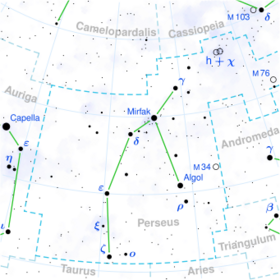Astronomy:Nu Persei
| Observation data Equinox J2000.0]] (ICRS) | |
|---|---|
| Constellation | Perseus |
| Right ascension | 03h 45m 11.63204s[1] |
| Declination | 42° 34′ 42.7829″[1] |
| Apparent magnitude (V) | 3.80[2] |
| Characteristics | |
| Spectral type | F5II[3] |
| U−B color index | +0.28[2] |
| B−V color index | +0.42[2] |
| Variable type | suspected[4] |
| Astrometry | |
| Radial velocity (Rv) | −12.10[5] km/s |
| Proper motion (μ) | RA: −14.45[1] mas/yr Dec.: +2.53[1] mas/yr |
| Parallax (π) | 5.86 ± 0.22[1] mas |
| Distance | 560 ± 20 ly (171 ± 6 pc) |
| Absolute magnitude (MV) | −2.39[6] |
| Details | |
| Mass | 5.01[7] M☉ |
| Radius | 20.62+1.72 −1.76[8] R☉ |
| Luminosity | 603.6±41.2[8] L☉ |
| Surface gravity (log g) | 3.04[9] cgs |
| Temperature | 6,300+287 −158[8] K |
| Metallicity [Fe/H] | +0.41[9] dex |
| Rotational velocity (v sin i) | 48.9[10] km/s |
| Age | 109[11] Myr |
| Other designations | |
| Database references | |
| SIMBAD | data |
ν Persei, Latinized as Nu Persei, is a single[13] star and a suspected variable in the northern constellation of Perseus. It has a yellow-white hue and is visible to the naked eye with an apparent visual magnitude of 3.80.[2] This object is located approximately 560 light-years from the Sun based on parallax[1] but is drifting closer with a radial velocity of −12 km/s.[5]
This object is a highly luminous bright giant star with a stellar classification of F5II.[3] It has five[7] times the mass of the Sun but has expanded to around 21[8] times the Sun's radius. The star has a relatively high rotation rate, spinning with a projected rotational velocity of 48.9 km/s.[10] It is radiating 604[8] times the luminosity of the Sun from its enlarged photosphere at an effective temperature of 6,300 K.[8]
Several visual companions beside the primary have been recorded. B, with magnitude 12.1 and separation 31.6", has its own companion, E, with magnitude 14.3 and separation 7.7". Additionally, C has magnitude 13.2 and separation 55.7", and D has magnitude 13.8 and separation 22.8".[14]
References
- ↑ 1.0 1.1 1.2 1.3 1.4 1.5 Van Leeuwen, F. (2007). "Validation of the new Hipparcos reduction". Astronomy and Astrophysics 474 (2): 653–664. doi:10.1051/0004-6361:20078357. Bibcode: 2007A&A...474..653V. Vizier catalog entry
- ↑ 2.0 2.1 2.2 2.3 Ducati, J. R. (2002). "VizieR Online Data Catalog: Catalogue of Stellar Photometry in Johnson's 11-color system". CDS/ADC Collection of Electronic Catalogues 2237. Bibcode: 2002yCat.2237....0D.
- ↑ 3.0 3.1 Hoffleit, D.; Warren, W. H. (1995). "Bright Star Catalogue". VizieR On-line Data Catalog: V/50. Originally Published in: 1964BS....C......0H 5050. Bibcode: 1995yCat.5050....0H.
- ↑ Samus, N. N. et al. (2009). "VizieR Online Data Catalog: General Catalogue of Variable Stars (Samus+ 2007-2013)". VizieR On-line Data Catalog: B/GCVS. Originally Published in: 2009yCat....102025S 1: B/gcvs. Bibcode: 2009yCat....102025S.
- ↑ 5.0 5.1 Gontcharov, G. A. (2006). "Pulkovo Compilation of Radial Velocities for 35 495 Hipparcos stars in a common system". Astronomy Letters 32 (11): 759–771. doi:10.1134/S1063773706110065. Bibcode: 2006AstL...32..759G.
- ↑ Anderson, E.; Francis, Ch. (2012). "XHIP: An extended hipparcos compilation". Astronomy Letters 38 (5): 331. doi:10.1134/S1063773712050015. Bibcode: 2012AstL...38..331A. Vizier catalog entry
- ↑ 7.0 7.1 Hohle, M.M. et al. (2010). "Masses and luminosities of O- and B-type stars and red supergiants". Astronomische Nachrichten 331 (4): 349. doi:10.1002/asna.200911355. Bibcode: 2010AN....331..349H. Vizier catalog entry
- ↑ 8.0 8.1 8.2 8.3 8.4 8.5 Brown, A. G. A. (August 2018). "Gaia Data Release 2: Summary of the contents and survey properties". Astronomy & Astrophysics 616: A1. doi:10.1051/0004-6361/201833051. Bibcode: 2018A&A...616A...1G. Gaia DR2 record for this source at VizieR.
- ↑ 9.0 9.1 Earle Luck, R. (2014). "Parameters and Abundances in Luminous Stars". The Astronomical Journal 147 (6): 137. doi:10.1088/0004-6256/147/6/137. Bibcode: 2014AJ....147..137L.
- ↑ 10.0 10.1 De Medeiros, J. R.; Mayor, M. (1999). "A catalog of rotational and radial velocities for evolved stars". Astronomy and Astrophysics Supplement Series 139 (3): 433. doi:10.1051/aas:1999401. Bibcode: 1999A&AS..139..433D. Vizier catalog entry
- ↑ Lyubimkov, Leonid S.; Lambert, David L.; Rostopchin, Sergey I.; Rachkovskaya, Tamara M.; Poklad, Dmitry B. (2010). "Accurate fundamental parameters for A-, F- and G-type Supergiants in the solar neighbourhood". Monthly Notices of the Royal Astronomical Society 402 (2): 1369–1379. doi:10.1111/j.1365-2966.2009.15979.x. Bibcode: 2010MNRAS.402.1369L.
- ↑ "nu. Per". SIMBAD. Centre de données astronomiques de Strasbourg. http://simbad.u-strasbg.fr/simbad/sim-basic?Ident=nu.+Per.
- ↑ Eggleton, P. P.; Tokovinin, A. A. (September 2008). "A catalogue of multiplicity among bright stellar systems". Monthly Notices of the Royal Astronomical Society 389 (2): 869–879. doi:10.1111/j.1365-2966.2008.13596.x. Bibcode: 2008MNRAS.389..869E.
- ↑ Mason, Brian D. et al. (2001). "The 2001 US Naval Observatory Double Star CD-ROM. I. The Washington Double Star Catalog". The Astronomical Journal 122 (6): 3466. doi:10.1086/323920. Bibcode: 2001AJ....122.3466M. Vizier catalog entry
External links
- Kaler, James B. (March 11, 2011). "Nu Persei". STARS. http://stars.astro.illinois.edu/sow/nuper.html.
 |

